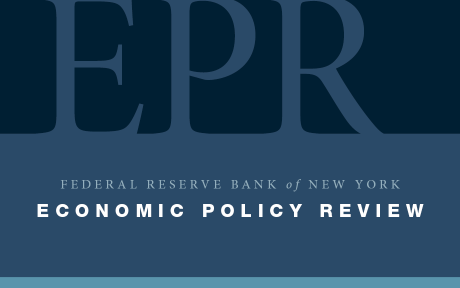
Antoine Martin, an economist and financial stability advisor in the New York Fed’s Research and Statistics Group, will soon take up a new post at the Swiss National Bank (SNB), as head of its third department covering money markets/foreign exchange (FX). In that role, Martin, who is originally from Switzerland, also becomes one of three members of that central bank’s rate-setting governing board. Readers of Liberty Street Economics will be familiar with his byline, as he has written more than sixty posts presenting new research findings and policy analysis, all with an eye for breaking down the most complicated topics in clear terms. He took a few questions from publications editor Anna Snider about his experiences and future plans as he prepares to move on.
Q: How did your role at the New York Fed change over the years?
I joined the New York Fed in 2005, after spending four years at the Kansas City Fed. I have been in the Research and Statistics Group throughout my time here. After the global financial crisis (GFC) in 2008, I got a lot more involved with policy work, notably with the tri-party repo infrastructure reform, money market funds reform, and the Federal Reserve’s monetary policy implementation long-term framework. More recently, I have worked on issues related to digital currencies and central bank digital currency (CBDC).
Q: What will you cover in your new role at SNB?
A: I am joining the SNB as head of the third department, which is based in Zurich. The SNB has three departments that focus on, respectively, monetary policy, financial stability, and money markets/FX. As head of the third department, my role will be similar to the one held by the head of the Markets Group at the New York Fed. The heads of the three departments also form the policymaking body for the SNB, the equivalent of the Federal Reserve’s Federal Open Market Committee.
Q: What has been your core research focus? Does that thread through all your work?
I was hired by the New York Fed in part for my expertise in the economics of payments. I had also done research on bank runs and the tools available to central banks to try to prevent them. When I joined the New York Fed, and especially after the GFC, two important things happened. First, I realized how much institutional details matter in economic outcomes. Second, I was exposed to a lot of fascinating and difficult policy questions. This had a profound effect on my research. It led me to focus more on policy-relevant questions and pushed me to integrate important institutional details in my analysis. One example could be the “unwind” of tri-party repo transactions, which contributed to the fragility of that market (and which I discussed on Liberty Street Economics in “Stabilizing the Tri-Party Repo Market by Eliminating the ‘Unwind.’”
Q. You have worked a lot on the “how” of monetary policy, thinking about the tools that underlie the Fed’s policy stance. What has it been like to see new tools go from blueprint to implementation?
It was super interesting and very exciting to see an idea, a floor system of monetary policy implementation underpinned by interest on reserves, go from something purely theoretical to becoming a key implementation tool, not only for the Federal Reserve, but also for many other central banks. I started working on floor systems with colleagues from the New York Fed before the GFC. Todd Keister, Jamie McAndrews, and I published our first paper on the topic, “Divorcing Money from Monetary Policy,” in the Economic Policy Review in 2008, before the Federal Reserve could pay interest on reserves. That authority was granted by the U.S. Congress effective October 1, 2008.
Looking back, I find it fascinating how much we had to learn about how a floor system works. A simple theoretical model is extremely helpful in helping us understand the key economic mechanisms that underlie a floor system, but the model has to be adapted to take into account institutional features. For example, I think most people didn’t anticipate that the effective federal funds rate would often trade below the interest on reserve balances (IORB). This development led to the creation of overnight reverse repurchase agreement (ON RRP) operations. Later, when the Federal Reserve began normalizing the size of its balance sheet in 2019, most observers were surprised that reserves would appear to be scarce even though the supply was still about $1.3 trillion (owing in part to frictions in the interbank market that has made it harder for institutions to redistribute reserves among themselves, as my co-authors and I explained in “The Market Events of Mid-September 2019,” also in the Economic Policy Review). Eventually, that led to the introduction of the standing repo facility. Some co-authors and I discussed the evolution of this implementation framework in a four-part Liberty Street Economics series in 2022 that lead with “How the Federal Reserve’s Monetary Policy Implementation Framework Has Evolved.”
Q: You have been a major contributor to Liberty Street Economics since its inception in 2011, with a gift for explaining complex institutional structures, market dynamics, and policy impacts. What readers do you have in mind when you write these?
In my view, one important role of economic researchers at a central bank is to help the public understand what the central bank does. We can do that by describing and analyzing the tools at the disposal of central banks and how these tools are used. We can provide an analytical perspective on the context in which decisions are made and the key trade-offs a central bank faces. As an example, Liberty Street Economics published several posts after the GFC and the events of March 2020 describing the facilities put in place to support the financial system and the American economy.
One of the reasons I have enjoyed working at the New York Fed so much is because I am fascinated by the role central banks play in the economy. When I write blog posts, I am hoping that readers will learn something about the markets in which the Fed operates and the challenge it faces.
Q: In recent years, you’ve been a guide for those interested in making sense of digital currencies and asset tokenization. How did you get drawn into this subject? How do you see these technologies fitting in to the financial ecosystem?
Given my background in the economics of payments, it felt natural for me to become interested in digital assets and cryptocurrencies. And, of course, it is also a very important issue for central banks, many of which operate at least some payment systems in their economy.
A lot of claims have been made suggesting that crypto- and/or digital currencies are going to transform the financial system. So, with my colleague Michael Lee, we tried to understand how these new systems work, how they might benefit consumers, how they could allow financial institutions to provide better services, and how they might be used by central banks to implement better policies. We wrote about these issues on the blog (see, for example, “Hey Economist! What Do Cryptocurrencies Have to Do with Trust?” and “Bitcoin Is Not a New Type of Money”).
It is still not entirely clear whether or how new technologies will change the payment landscape. While a lot of attention has focused on cryptocurrencies, like Bitcoin, they are rarely used for payments. Instead, instant payment systems have led to profound changes in the payment landscape in some countries. In Sweden, for example, Swish contributed to a dramatic decline in the use of cash. In Brazil, Pix usage has exceeded expectations and contributed to financial inclusion. With the availability of the FedNow Service, we can hope that instant payments will develop further in the U.S. as well.
Q: You speak (at least) three languages—English, French, and German—plus the tongues of math and economics. Which do you use most and how will that change in your new position?
Saying that I speak German is a bit of a stretch. Even though I took German through high school, I forgot most of what I knew. I have been studying it intensively in the last few months and I am excited to have a chance to become fluent in that language. I think that an important aspect of communication is to know your audience and I will have to adapt in my new role. So, I will probably speak a little bit less in math and in English and a little bit more in German and in French.
Disclaimer
The views expressed in this post are those of the author(s) and do not necessarily reflect the position of the Federal Reserve Bank of New York or the Federal Reserve System. Any errors or omissions are the responsibility of the author(s).













 RSS Feed
RSS Feed Follow Liberty Street Economics
Follow Liberty Street Economics